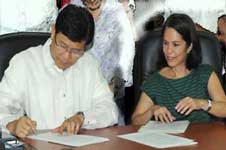DENR TO THE PUBLIC: BIKE, HIKE AND PLANT A TREE FOR MOTHER NATURE
The Department of Environment and Natural Resources (DENR) invites all Filipinos who have a passion for riding bicycles and taking care of the environment from all sectors to join the “Bike. Hike. Plant. Celebrating 153 years of Philippine Forestry Service” on June 25, 2016. Registration is still on-going.
The event is being spearheaded by the Forest Management Bureau (FMB), a staff bureau under the DENR, as part of its sesquicentennial anniversary celebration.
“The forestry service in the country has come of age as foresters are now regarded as significant players in nation-building as evidenced by the enactment of Republic Act (RA) 10690, otherwise known as the Forestry Profession Act of 2015,” DENR Secretary Ramon J. P. Paje said.
Looking back, Paje said that while the forestry sector had contributed immensely in the economic growth of the country, such gains had its consequences resulting in the degradation of upland areas which, in turn, impoverished the people in the countryside due to low productivity.
But interest in forestry has come to fore once again in the light of climate change.
“The restoration of forests remains one of most viable mitigation measures against the impacts of climate change. It is for this reason that President Aquino expanded the implementation of the National Greening Program (NGP) up to 2028 to continue with the reforestation of the remaining denuded and degrade areas of the country,” Paje stressed.
NGP is the massive reforestation program of the Aquino administration. Started in 2011, it sought to plant 1.5 million hectares by end of 2016.
According to Paje, protecting the environment is as essential as taking care of one’s health, so the volunteers will be able to maximize their participation in the activity.
The goals of the event include widening the network of forestry champions and including the bikers and hikers in rehabilitating and protecting the Philippine forests through the promotion of responsible tourism and proactive forestation.
“By planting trees through these activities, we will be able to achieve a carbon-free Philippines gradually,” Paje points out.
The Philippines made a commitment during the United Nations Climate Change Conference (COP21) in Paris, France last year to reduce the carbon emissions by up to 70% through the Intended Nationally Determined Contributions or INDCs.
“As a highly vulnerable country, the Philippines has committed early to contributing its fair share to the global action,” Paje said.
Planting trees is one of the methods used for carbon mitigation. Accordingly, the carbon sequestration capacity of a tree is generally much faster on its early age, one reason why tree planting is highly encouraged.
Expected participants include 100 volunteer riders from 50 corporate, government, media, and private bike organizations. There will also be an additional 50 volunteer hikers from various agencies who will receive the seedlings and plant these on the site. Some 400 cyclists will also join the volunteer riders to show their support for the delegation.
Route starts from the DENR’s Environmental Management Bureau parking lot in Quezon City up to the Mt. Sainai, Pintong Bocaue in San Mateo, Rizal, which is a part of the Upper Marikina River Basin Protected Landscape. Assembly time and distribution of planting kits and seedlings will be at 4:00 AM.
The kits that will be given to the participants will be placed in drawstring bags made from nylon silverback fabric. The bag has two pockets which can hold the two seedlings. These two seedlings will be carried by each of the volunteer cyclist up to the planting site.
“We hope that through this biking, hiking and tree planting event, the volunteer cyclists, while sustaining the pink of their health, will be able to entice people from other sectors to meet our carbon emission goals and finally achieve our collective goal for the environment,” Paje said. ###
- Details
- Parent Category: News & Events
- Category: Press Releases




